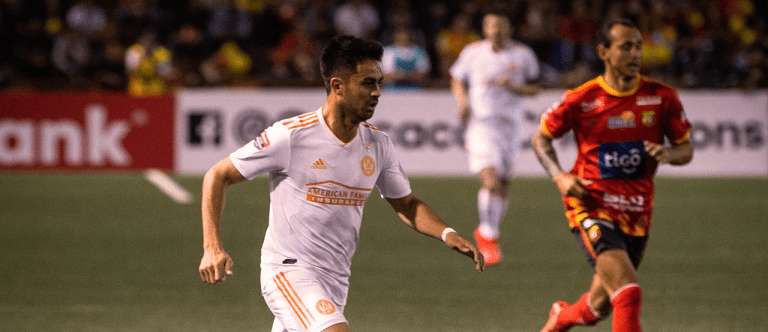Every MLS offseason has a theme. A narrative that monopolizes the months between the matches. This winter, we didn’t have to dig deep to find it. The 2018-19 offseason was all about the league’s emergence on the global market. In terms of incoming signings and outgoing sales, MLS unquestionably became a bigger presence in the world transfer market this winter than at any other point in its 23-year history.
“It’s the natural evolution of MLS,” said one GM, one of four high-ranking club executives, all of whom requested anonymity, who spoke to MLSsoccer.com in the reporting of this story. “We’re a growing league that’s garnering more respect. Our level of play has gone up considerably in the last three, four, five years and when that happens you become more of a player on the world market.”
We only need to look to the January ledger for proof. Alphonso Davies was sold by Vancouver to Bayern Munich for a record fee of $13 million. Atlanta shattered that mark soon after by moving Miguel Almiron to Newcastle United for a reported $27 million fee. Columbus Crew SC goalkeeper Zack Steffen was bought for between $7-10 million by Manchester City, who he’ll join this summer. Tyler Adams was sold by the New York Red Bulls to their sister club, RB Leipzig. Orlando’s Yoshi Yotun moved to Mexican club Cruz Azul for a reported fee of $4 million. Sebastian Giovinco and Victor Vazquez both left Toronto FC for Middle Eastern clubs for significant sums. Alejandro Silva was sold by Montreal to Paraguayan club Olimpia for multiple millions. A player who never even played a second in MLS, teenage FC Dallas academy product Chris Richards, joined Davies at Bayern for $1.25 million. Altogether, that’s around $60 million in outgoing transfers.
The evidence isn’t only in the sales that were completed – even the deals that didn’t get done were more notable than ever before. There was Paris Saint Germain’s near-swoop for D.C. United’s Luciano Acosta, Barcelona’s reported interest in LAFC’s Carlos Vela, Seattle’s Nico Lodeiro once more catching the eye of Boca Juniors and reported European offers for Houston’s Alberth Elis and Mauro Manotas. The list goes on.

Pity Martinez has already made his presence felt after joining Atlanta for an MLS record fee. | Atlanta United
The incoming moves were nearly as significant. Pity Martinez joined Atlanta for $17 million, the highest fee paid for an incoming player in league history. Alexandru Mitrita signed with NYCFC for an $8.5 million fee. Highly sought-after South Korean prospect Inbeom Hwang inked a Designated Player deal with Vancouver. According to sources, more big-money players could soon arrive in Toronto, who are reportedly closing in on an $11.4 million transfer for Alejandro Pozuelo, and Portland, who recently had an $8.5 million offer for Tigres forward Eduardo Vargas rejected and are still looking to sign a DP striker.
The league’s growth in the global market has far-reaching implications. It’s adding new wrinkles to how clubs manage players and transfer negotiations and, at least in some cases, changing the way ownership groups think about how they spend their money.
The Adams and Davies transactions show that teams can get significant financial returns from their academies. The executives I spoke to believe those sales will lead some clubs to increase their investment in their youth systems. The Almiron sale was on an even higher level. Atlanta bought the Paraguayan for a reported fee of $9 million dollars and, per the MLS Players Association, paid him $4.6 million total in his two seasons in the league. That’s an overall spend of $13.6 million followed by a $27 million sale. Atlanta don’t keep the entire fee – 25 percent goes to MLS – but that’s still a significant profit, and it doesn’t even touch on the incredible impact Almiron had both on and off the field in Atlanta.
Other owners see a deal like that and, according to the execs, naturally want in on the action. Some who previously viewed transfer fees simply as a cost are now starting to think of them more as investments, albeit higher-risk ones than they might be used to in the business world.
“It’s inevitably changing their thought process, there’s no question,” said one GM. “… Many of the people that own these teams, they’re not ‘soccer guys,’ they’re businessmen and women, but they’re starting to see that this can be a business if you put a model together correctly.”
“I think we may see some evolution there, yeah,” said a second executive. “If you look at Atlanta’s model, if you have large amounts of capital to lay out and some tolerance for risk, the amortized costs of those deals are similar to some of those bigger DP deals from the past. And then the player has resale value. Instead of him just aging out and then maybe you get a little something on the back end, you can sell for a big net gain. So, I do think there’s something to be said for making these investments. But it does require deep pockets and lots of capital and tolerance for risk, because no one is ever going to hit 100 percent.”
A natural extension of that shift in thinking is that more teams will lean into that model. As players like Adams and Almiron succeed in Europe and as MLS emerges as a more popular, pricier market, the executives envision a future where selling players turns into the biggest revenue stream for some teams and a major driver of profits for many more.
“Some of the smaller markets, this might become their chief source of revenue,” said the second exec. “And likewise, I think there are going to be some clubs at the top that will be more willing to spend money and be less concerned about the bottom line in terms of coming in and going out and they may be more dominant on the field. So, I think it’s going to be an evolving paradigm for general managers.”
For a league whose primary focus has long been on the buying side of the market for so long, frequently selling players will be a significant adjustment. Teams will have to have firm transfer prices for all their players and an idea of the timing of potential sales several transfer windows in advance. They’ll have to identify potential replacements several windows in advance as well and be ready to move on those replacements as soon as – or even before, as we saw with Atlanta signing Martinez before they sold Almiron this winter – they transfer a player abroad. All of that will require better scouting and recruiting, a realistic grasp on what their players are worth and an ability to resist getting too greedy in the final stages of negotiations.
“I think that’s the really kind of tricky part,” said a third exec. “All of a sudden, you have to work a couple of transfer windows out to think, ‘OK, we have this player, when do we think his likely exit point is and how do we efficiently plan for that so that we know if we do get an offer that meets our value, how can we replace him?’ I think those are different and unique challenges that we haven’t had before.”
On a more micro level, MLS’s growing presence on the world market will create some complications in how clubs manage players. We saw a few such cases this winter. Acosta’s almost-move to PSG was one of the most dramatic will-he or won’t-he transfer sagas in league history. According to sources with knowledge of negotiations, the back-and-forth was uncommonly high-stakes and uncommonly stressful for both player and club and will likely loom large in any discussions about a new contract for Acosta, whose current deal expires at the end of the year.
Almiron’s move to Newcastle wasn’t as public a spectacle, but it did come down to the wire, with Atlanta, per sources, struggling to get their desired price from the English club until a late bid from Serie A side Napoli drove up the final number. Atlanta also dealt with some additional drama from midfielder Darlington Nagbe, who, per a report, requested a trade to Columbus in January and subsequently missed part of preseason camp. He wasn’t the only player around the league to allegedly hold out, as Giovinco ditched TFC training before he was eventually sold to Saudi Arabian club Al-Hilal. Toronto’s pursuit of Pozuelo has been entirely bizarre as well, with the Spaniard threatening legal action against his current club Genk in order to facilitate a move to Ontario.

Sagas like Lucho Acosta's could become more common the more MLS integrates itself into the global market. | USA Today Images
Theatrics like these have happened all around MLS over the years, but not with this sort of frequency. As teams spend more money on incoming players and sell more and more players abroad, transfer sagas and tense holdouts will only occur more often. Dealing with those types of problems requires a deft touch from club executives, many of whom didn’t have to regularly contend with these sorts of issues when MLS was a lower-spending, more isolated league than it is today. The executives acknowledged that there will be a learning curve.
The full implications of the league’s increased presence in the world market aren’t completely clear, but there’s no doubt that MLS has carved out a bigger role in the global game in recent months. The money has gotten bigger. The stakes have gotten higher. After operating for years in a relatively insular system, MLS clubs are adjusting to their brave new world. According to the execs, that’s a very good thing.
“I think the main part for me is that we’re trending in a really good direction right now. I think this is a really good direction for the league,” said the third exec. “I think when the Commissioner talks about it very publicly as he did a couple months ago, I think that’s huge for the league… and for all the clubs to want to participate in this.
“We can still be a league of choice and a selling league. Those two things aren’t mutually exclusive. We were a league of choice for Almiron for two years, for an important part of his career, and every time he’s mentioned on TV with Newcastle, Atlanta are going to get massive props and massive credit for identifying. That’s a huge thing for MLS. I think we’re trending in a really, really good direction and I think from a club side, I think it’s a really exciting part of the new world of MLS that just didn’t exist a few years ago. There were of course some players sold, but now the levels are different. The interest level is different. It’s really exciting times.”










